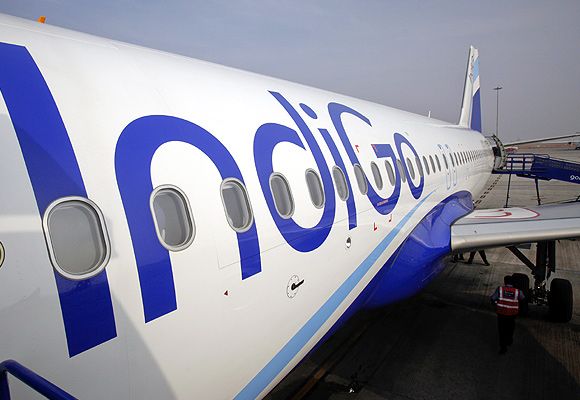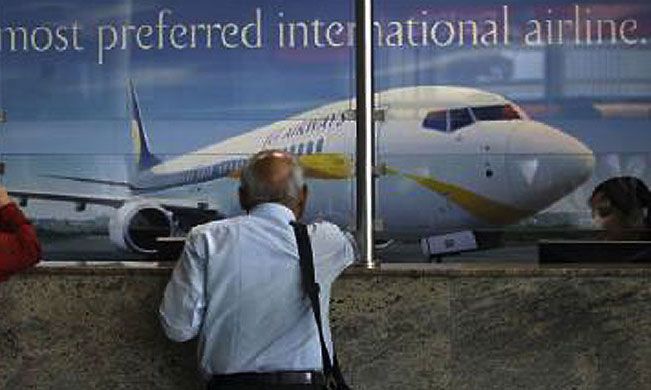For Jet Airways, operating environment has remained tough and competition has intensified, resulting in Jet losing passengers and market share.

The past year and a half has been tumultuous for Jet Airways.
It saw Etihad's investment, a record annual loss (2013-14) of Rs 4,129 crore (Rs 41.29 billion) and a nearly 60 per cent drop in its stock price – in 12 months, the scrip is down 27 per cent.
The operating environment has remained tough and competition has intensified, resulting in Jet losing passengers and market share.
A financial turnaround with the Etihad partnership and debt restructuring has not fully materialised.

The stock began rising from October-November 2012, as the airline management started the negotiations with Etihad to sell 24 per cent stake.
By January 2013, when the airline first confirmed the talks, the stock had risen to Rs 607, a rise of 75 per cent over the October 2012 price.
In April 2013, when it signed the Rs 2,057-crore deal, the stock reached a high of Rs 688.60. Since then, it is in a downtrend; it currently trades around Rs 212.

Back in July 2013, stock market analysts were hopeful that the stock, down to under Rs 500, would zoom to a new high again, in 12-18 months.
The short-term outlook was not positive, went the view; yet, the airline would benefit in the long term, with growth in passenger traffic.
Red sea
So far, however, Jet has struggled to return to profitability.
It did manage to contain the loss in the first quarter of FY15. Yields improved in the quarter, on the back of a rise in ticket prices.

Better utilisation of aircraft, lower interest costs and an exceptional gain of Rs 49.5 crore helped bring down overall losses.
Adjusted for exceptional items, the loss was Rs 237 crore, ahead of the Rs 327 crore estimate.
Two months earlier, Jet chairman Naresh Goyal announced a change in strategy.

This included a phasing out of its no-frills brand, Konnect, growing of international operations and a plan to return to profitability by 2017.
The market share has been declining every quarter since July-September of FY14 and is a far cry from the peak of 29.3 per cent in the March quarter of FY13.
The company (Jet Airways and JetLite) continues to trail market leader IndiGo by a wide margin.
The latter has 32.6 per cent and the Jet-JetLite combine 20.1 per cent, as on August, slightly more than SpiceJet’s 19.5 per cent.

While Jet lost domestic market share as it cut capacity, data from the Directorate General of Civil Aviation show the airline has been carrying fewer passengers per flight than its rivals.
In 2013, Jet reported a load factor of 71.5 per cent. This is an indicator of occupancy and Jet's loads were lower than GoAir, IndiGo and SpiceJet, and only marginally higher than Air India.
Even in the first seven months of 2014, its load factors were among the lowest in the sector, far lower than what was required for break-even on domestic routes.
Jet's domestic operations contributed about 45 per cent of total revenue and nearly 70 per cent of its pre-tax loss on a standalone basis in FY14.

Not surprisingly, it is focusing on the more profitable international routes. Barring the March quarter, operations abroad have seen healthy margins (June quarter at 7.2 per cent) at the operating level.
Domestic operations have not made money at the operating level for the past seven quarters.
Growth in international revenue is one reason Jet posted a robust revenue growth of 13 per cent year-on-year for the June quarter.
While international revenue was up 24 per cent, domestic revenue was up barely one per cent. Over FY11-14, the share of international operations has risen to 53 per cent of total revenue, against 51 per cent earlier.
 Analysts at ICICI Securities believe with Etihad coming on board with a 24 per cent stake and regulatory approval to code-share 43 additional routes, revenue from international operations should move to 60 per cent of the total.
Analysts at ICICI Securities believe with Etihad coming on board with a 24 per cent stake and regulatory approval to code-share 43 additional routes, revenue from international operations should move to 60 per cent of the total.
Optimism, caution
While there are many parameters Jet has to work on, the skies seem to be clearing.
First, passenger traffic. This measure is up seven per cent in the financial year-to-date, with the industry having flown 5.7 million passengers in August, the second highest in a little over 30 months.
Second, crude oil prices are down 12 per cent since the start of the year and as this cost is an average of 40 per cent of an airline's sales, it will be a big relief for Indian carriers.
Fuel costs as a percentage of sales declined to 39.6 per cent for Jet in the June quarter as against 42.8 per cent in the March one.
Any further decline in fuel costs, coupled with a rise in loads, should improve its profitability.

Further, any strengthening of the rupee should improve operating cash flows as well, given the dollar-denominated costs such as for lease and maintenance.
However, for the stock to re-rate, there has to be consistency in the operating performance in the coming quarters.
While Jet has prepared a strategy to focus on the full-service business and can cut costs, some factors which could decide its future are beyond its control.
The biggest of these, key reason for the mess in the sector, continues to be cut-throat competition, worsened by over-capacity.
HSBC Global Research analysts Rajani Khetan, Mark Webb and Achal Kumar said in a June report, "Years of chronic over-capacity and high costs are key industry challenges. Structural deterioration (is) to continue as more supply and new competitors enter (the market). We estimate narrow-body seat supply growth (domestic market) will accelerate from eight per cent in FY14 to 11-15 per cent over FY15-17.
More, two new airlines (AirAsia and Tata Singapore) will likely cause further market fragmentation and increase competitive pressures.”












 © 2025
© 2025